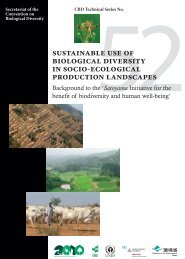INDIAN SCIENCE CONGRESS - India Environment Portal
INDIAN SCIENCE CONGRESS - India Environment Portal
INDIAN SCIENCE CONGRESS - India Environment Portal
Create successful ePaper yourself
Turn your PDF publications into a flip-book with our unique Google optimized e-Paper software.
12<br />
Proc. 98th <strong>India</strong>n Science Congress, Part II : Presidential Address<br />
and Gregory, 1980). Two more species have been now recorded from N. W.<br />
Himalayas. These are : a new species of Tricholoma and T. virgatum (Fr. ex. Fr.)<br />
Kummer. The latter has been observed growing in mycorrhizal association with C.<br />
deodara (Lakhanpal, 1986 : Kumar, 1987).<br />
The genus Tricholomopsis is so far represented by two species from <strong>India</strong>,<br />
one from U. P. (Singh and Mehrotra, 1974) and other from Eastern Himalaya (T.<br />
rutilana, Sarwal, 1984). Kumar (1987) and Lakhanpal (1986) recorded T. rutilans<br />
(Schaeff. ex. Fr.) Singer and T. sulphureoides (Peck) Singer from N. W.<br />
Himalayas for the first time.<br />
In the genus Flammulina only F. velutipes (Curt ex. Fr.) Karst. has been<br />
reported so far from <strong>India</strong> and Himalaya. In the genus Lyophyllum represented by<br />
four species in <strong>India</strong>, has not been recorded so far from Himalayan ranges.<br />
Lakhanpal (1986) recorded L. decastes (Fr. Ex. Fr.) Singer from H. P.<br />
In the genus Resupinatus Watling and Gregory (1980) recorded R. applicatus<br />
from Kashmir and in the genus Xeramphalina, out of the three species recorded<br />
from <strong>India</strong> and Himalayas, X. aurara Horak and X. campanella (Batsch. ex. Fr.)<br />
Maire, have been recorded from N. w. Himalaya (Watling and Gregory, 1980)<br />
II. Systematics of morels<br />
The genus Morchella (Ascomycetes) commonly know as morels and ‘Guchhi’<br />
in the <strong>India</strong>n market is at present, the costliest and most sought after wild<br />
mushroom. It has an excellent flavour and is highly prized for its culinary aspects.<br />
Morel collections generate extra income for the local inhabitants. Attempts have<br />
been made to domesticate it but success has been only partial. Therefore, studies<br />
were undertaken to investigate all possible aspects of morel biology (Shad, 1989;<br />
Lakhanpal and Shad 1999, Shad and Lakhanpal, 1991, Thakur 2001, Rana, 2002,<br />
Lakhanpal et al. 2010). All the six classical species viz. M. angusticeps, M.<br />
conica, M. crasispes, M. deliciosa, M. esculenta and M. semilibera have been<br />
collected and described from the Himalayan region.<br />
The systematics of genus Morchella and its species has been in a state of<br />
flux. Presently though most of the authors favour a six species concept, even for<br />
these species there is little consensus. On the basis of morphological features, out<br />
of the four species in M. esculenta complex. (M. esculenta, M. deliciosa, M.<br />
conica and M. crassipes), M. conica M. crassipes have at least one distinguishing<br />
characteristics each (conical shape in the former and swollen stipe in the latter)
















